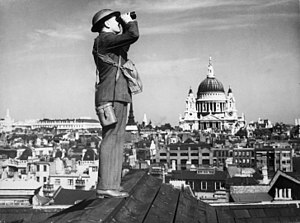Battle of Britain
| Battle of Britain | |||||||
|---|---|---|---|---|---|---|---|
| Part of the Second World War | |||||||
 An Observer Corps spotter scans the skies of London. |
|||||||
|
|||||||
| Belligerents | |||||||
|
|
|
||||||
| Commanders and leaders | |||||||
|
|
|
||||||
| Units involved | |||||||
|
Air Force |
|
||||||
| Strength | |||||||
| 1,963 serviceable aircraft |
2,550 serviceable aircraft. |
||||||
| Casualties and losses | |||||||
| 544 aircrew (RAF Fighter Command), 718 (RAF Bomber Command), 280 (RAF Coastal Command) killed 422 aircrew wounded 1,744 aircraft destroyed |
2585 aircrew killed and missing, 925 captured, 735 wounded 1,977 aircraft destroyed, 1,634 in combat and 343 non combat |
||||||
| Around 90,000 civilian casualties, 40,000 of them fatal. | |||||||
2,550 serviceable aircraft.
The Battle of Britain (German: die Luftschlacht um England, literally "Air battle for England") was a combat of the Second World War, when the Royal Air Force (RAF) defended the United Kingdom (UK) against the German Air Force (Luftwaffe) attacks from the end of June 1940. It is described as the first major campaign fought entirely by air forces. The British officially recognise its duration as from 10 July until 31 October 1940 that overlaps with the period of large-scale night attacks known as the Blitz, while German historians do not accept this subdivision and regard it as a campaign lasting from July 1940 to June 1941.
The primary objective of the Nazi German forces was to compel Britain to agree to a negotiated peace settlement. In July 1940, the air and sea blockade began with the Luftwaffe mainly targeting coastal shipping convoys, ports and shipping centres, such as Portsmouth. On 1 August, the Luftwaffe was directed to achieve air superiority over the RAF with the aim of incapacitating RAF Fighter Command and, 12 days later, it shifted the attacks to RAF airfields and infrastructure. As the battle progressed, the Luftwaffe also targeted factories involved in aircraft production and strategic infrastructure and, eventually, it employed terror bombing on areas of political significance and civilians.
By preventing the Luftwaffe's air superiority over the UK, the British forced Adolf Hitler to postpone and eventually cancel Operation Sea Lion, a proposed amphibious and airborne invasion of Britain. However, Nazi Germany continued bombing operations on Britain, known as the Blitz. The failure to destroy Britain's air defences to force an armistice (or even outright surrender) is considered by Steven Bungay to be the Nazis' first major defeat in World War II, and a crucial turning point in the conflict.
...
Wikipedia
